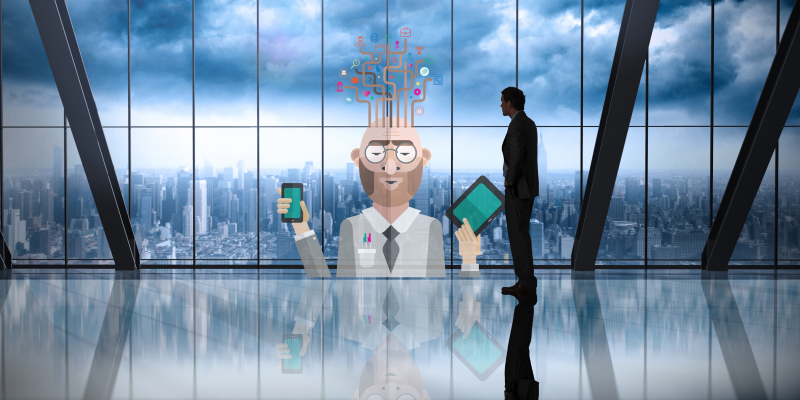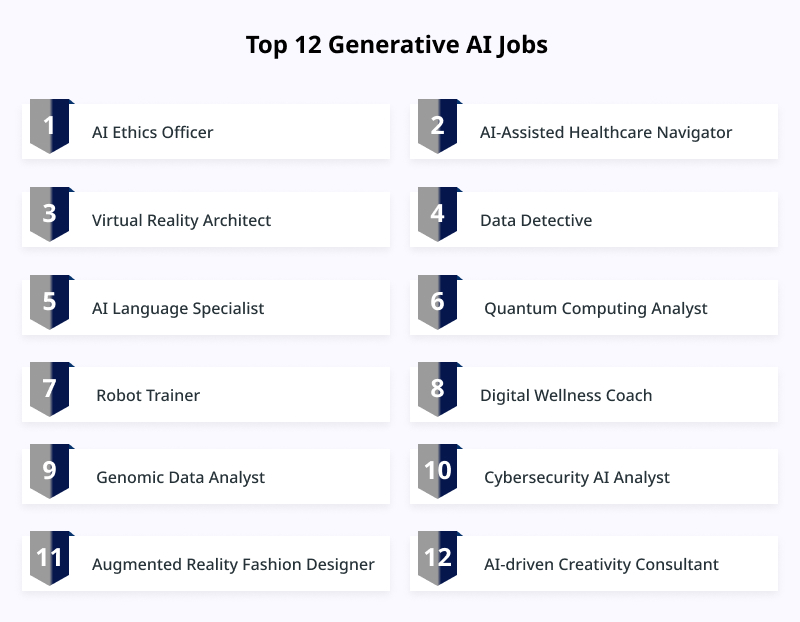The current world is increasingly transforming with generative AI, and traditional career paths are making way for a wave of exciting possibilities.
Ever wondered what its like to be an AI Ethics Officer or a Quantum Computing Analyst?
This blog explores 12 cutting-edge professions emerging in the Generative AI Jobs Era. We’ll navigate through roles that blend human ingenuity with artificial creativity, offering you a glimpse into a realm where AI and human potential converge.
Top 12 Jobs for Generative AI
A revolutionary wave is transforming the job environment as we approach the era of generative AI jobs. Here’s a closer look at the cutting edge of employment options that combine artificial intelligence’s capability with human creativity:
1. AI Ethics Officer
The ethical implications of artificial intelligence technologies have gained significant importance in the era of generative AI. AI Ethics Officers guarantee responsible and ethical procedures in creating and applying AI systems. They must navigate the tricky nexus of morality and technology while considering potential biases and societal repercussions. Some AI Ethics OfficerAI Ethics Consultants’ opportunities and responsibilities include:
- Creating moral standards and regulations for creating and applying AI.
- Risk assessment involves locating and assessing any ethical concerns AI systems may pose.
- Teaching internal and external stakeholders about AI ethics is known as stakeholder education.
- Making sure that laws and regulations about AI ethics are followed.
- Keep an eye on AI systems, evaluate them for moral implications, and suggest changes as necessary.
2. AI-Assisted Healthcare Navigator
Generative AI is revolutionizing the healthcare industry, and AI-Assisted Healthcare Navigators are emerging as major participants in this development. To provide patients with individualized healthcare alternatives and treatment regimens, these specialists combine AI with medical experience. The responsibilities are:
- Talking with patients to learn about their preferences, worries, and medical history.
- AI analysis uses various algorithms to examine diagnostic data, patient data, and medical records.
- Offering individualized therapy suggestions derived from AI-powered examination.
- Serving as a point of contact for patients and healthcare professionals to guarantee clear communication.
- Outcome monitoring is regularly assessing patients’ progress and modifying treatment regimens.
3. Virtual Reality Architect
The job of a Virtual Reality (VR) Architect has become increasingly important in creating immersive digital experiences in the age of generative AI services. These architects are in charge of creating virtual spaces that are not limited by conventional lines. Their main goal is to design environments that may be used for various purposes, such as simulations, teaching, and entertainment. Its responsibilities are:
- Creating virtual environments focusing on education, training, or gaming.
- Adding artificial intelligence components to virtual reality settings to enhance user engagement.
- Ensuring virtual places are entertaining, intuitive, and user-friendly is called UX optimization.
- Bringing virtual visions to life through cross-functional teamwork.
- For cutting-edge virtual experiences, keep up with new AI and VR technology developments.
4. Data Detective
The emergence of generative AI jobs has given rise to the position of “Data Detective,” filled with professionals skilled at sifting through large datasets to extract valuable insights. These detectives are essential in analyzing patterns, trends, and anomalies in a data-rich world, enabling firms to make well-informed decisions based on useful information. It includes:
- Utilizing advanced analytics to analyze large datasets and extract insights for strategic decision-making.
- Dealing with issues about consistency, integrity, and quality of data.
- Presenting findings in reports, presentations, and visualizations to stakeholders who are not technical.
- Keeping up with the most recent developments in AI and data science to continuously improve your skills.
- Linking data-driven insights with corporate objectives by collaborating with data scientists, engineers, and decision-makers.
5. AI Language Specialist
Artificial Intelligence Language Specialists are essential to improving human-computer communication. These professionals ensure smooth and organic contact by bridging the gap between the complexities of human language and the algorithms that drive AI. Among the responsibilities are:
- Utilizing NLP methods to improve AI’s comprehension of subtleties in human language.
- Crafting conversational and contextually appropriate language for virtual assistants, chatbots, and other AI-powered applications.
- Customizing and improving already-trained language models to meet the demands of certain markets or communication scenarios.
- Working with UX designers to enhance user experience and optimize conversational interfaces.
- AI language specialists advance communication technology, improving the usability and efficiency of AI interactions for people in various contexts.
6. Quantum Computing Analyst
Quantum Computing Analysts explore the cutting-edge field of quantum computing in the generative AI era, pushing the limits of computer capacity. These experts use the laws of quantum mechanics to process data at previously unheard-of speeds, opening up new avenues for solving challenging problems. Among the responsibilities are:
- Developing and refining quantum algorithms to tackle intricate computational tasks.
- Working with engineers to improve the hardware for quantum computing in terms of efficiency and dependability.
- Utilizing the powers of quantum computing to address issues unique to certain industries, such as healthcare and finance.
- Keeping up with advances in quantum computing and implementing cutting-edge techniques in practical applications.
7. Robot Trainer
As robot technology advances in the generative AI era, the Robot Engineer Trainer career becomes increasingly important. These experts are in charge of instructing and directing robots so they can travel and carry out activities in actual situations.
Beyond simple programming, their specialty is building context-aware, adaptable robots that navigate challenging situations. The following are the main responsibilities of a robot trainer:
- Create and put into use algorithms that control a robot’s actions and reactions in various scenarios.
- Teach robots to perceive, understand, and react to sensory information, including visual identification and surrounding signals.
- To promote resilience in dynamic contexts, teach robots to adjust to unanticipated changes in their surroundings.
- Assure smooth communication between humans and robots while strongly emphasizing cooperation and safety.
8. Digital Wellness Coach
The Digital Wellness Coach appears as a mentor, assisting people in finding a good balance between their digital lifestyles and general well-being in a time when technological advancements rule the roost.
These trainers address the psychological and physical effects of prolonged digital involvement as technology becomes increasingly ubiquitous. The following are a Digital Wellness Coach’s main responsibilities:
- To learn about people’s digital habits, stressors, and areas for development and conduct assessments.
- Create individualized plans incorporating mindful technology practices to improve digital well-being.
- Educate people on the possible negative effects of excessive screen time, using social media, and experiencing digital weariness.
- Introduce methods for reducing stress appropriate for the digital age, fostering mental and emotional health.
9. Genomic Data Analyst
Genomic data analysts are essential to solving the riddles in our DNA in the age of generative AI. By utilizing cutting-edge artificial intelligence technology, these experts examine extensive genomic datasets to significantly contribute to personalized medicine, genetic research, and hereditary disease knowledge. The responsibilities are:
- Decipher intricate genomic data to find trends, variances, and possible connections.
- Utilize AI techniques to process and analyze data more advanced in bioinformatics workflows.
- Work with genetic counselors to provide patients with practical insights based on research findings.
- Investigate genetic markers closely with research teams to further scientific understanding.
- Provide information that directs the creation of individualized treatment regimens based on unique genetic profiles.
10. Cybersecurity AI Analyst
Cybersecurity AI analysts are at the forefront of strengthening digital defenses through artificial intelligence integration in the age of increasing cyber threats. These experts protect the security and integrity of digital systems by using AI techniques to anticipate, identify, and react to cyber attacks instantly. The major responsibilities are:
- Use AI algorithms to evaluate and spot possible weaknesses and dangers in cybersecurity.
- Create AI-driven procedures to respond to cybersecurity events quickly and efficiently.
- AI can be used to track and examine user behavior patterns to spot irregularities that can point to security breaches.
- Put in place AI-driven, adaptable security measures that change in response to new threats.
- Use AI technologies to proactively detect and reduce hazards by continuously monitoring system activity and network traffic.
11. Augmented Reality Fashion Designer
Fashion designers specializing in Augmented Reality (AR) are transforming how we view apparel and accessories in the ever-changing field where technology and fashion collide. These designers use augmented reality upgrades to create clothes that come to life, effortlessly fusing the real and virtual worlds. Their responsibilities are:
- Creating apparel and accessories with augmented reality components.
- Creating virtual runway displays with interactive digital elements to improve the runway experience.
- Supplying customers engaging with AR fashion with a smooth and eye-catching user experience.
- Collaborating closely with AR developers to integrate and debug AR elements into fashion designs.
12. AI-driven Creativity Consultant
In the era of generative AI, fostering the synergy between artificial intelligence and human creativity requires the assistance of an AI-driven creativity consultant. These experts steer the collaboration process between AI systems and human creatives, acting as catalysts for creativity. Responsibilities include:
- Creating plans for using AI in artistic endeavors while retaining human creativity.
- Holding workshops to encourage groups to investigate cutting-edge AI uses in their artistic projects.
- Encouraging cooperation to co-create original projects involving AI developers, designers, and artists.
- Offering clarifications and addressing any possible issues around the moral application of Artificial Intelligence (AI) Services in creative industries.
Final Words
The generative AI era promises exciting, lucrative, and innovative job opportunities. These positions, whether as AI Trainers, Explainers, Sustainers, or Ethics Managers, not only hold the potential to steer advancements in AI technology but also serve as platforms to address and uphold ethical, social, and professional aspects associated with it.
Embracing this shift to AI isn’t about rendering humans redundant but refocusing human skill, creativity, and strategy in exciting new directions.
All in all, these jobs are not a challenge but an opportunity to learn, grow, and develop.

